Quality of dental restorations. FDI Commission Pro... - ResearchGate
Quality of dental restorations. FDI Commission Pro... - ResearchGate
Quality of dental restorations. FDI Commission Pro... - ResearchGate
You also want an ePaper? Increase the reach of your titles
YUMPU automatically turns print PDFs into web optimized ePapers that Google loves.
140<strong>of</strong> various local aetiological factors,when assessing the associationbetween periodontal disease and<strong>restorations</strong>. Reported restorationparameters include the axiogingivallocation <strong>of</strong> the restoration margin,the location <strong>of</strong> the contact area andthe axial contour <strong>of</strong> the restoration.Other factors are the plaqueretentive ability, chemical state androughness <strong>of</strong> the restorative material,the occurrence and size <strong>of</strong>overhangs and crevices, and thepossible contributing effects <strong>of</strong> arestoration on an adjacent tooth.Adverse effects on the s<strong>of</strong>ttissues have been attributed either toimproper contact areas with foodimpaction 226 or to details such assurface roughness, contour gaps andoverhangs. Within limits, it appearsthat surface roughness does notlead to gingival changes 218,219,227 .There is general consensus thatall factors that enhance theaccumulation <strong>of</strong> plaque promoteperiodontal disease. Therefore,cavity designs that increase theprevalence <strong>of</strong> restoration discrepanciesindirectly cause supportivetissue breakdown. The prevalence<strong>of</strong> gingival restoration margindiscrepancies varies among differentreports. One major reason is the lack<strong>of</strong> common assessment techniquesand a common terminology.AestheticsThe topic <strong>of</strong> aesthetics includesboth the qualities <strong>of</strong> shape andappearance 228 . Shape depends on theoperator’s ability to contour andfinish the surface, as well as thematerial’s wear resistance. Appearancedepends primarily on materialoptical properties <strong>of</strong> colour andtranslucency. Metamerism, (a differencein colour appearance that varieswith the light source) is also acommon concern in aesthetic dentistry.The same concern exists forfluorescence <strong>of</strong> materials and teeth.Many would argue that a highlypolished, anatomically correct castingor amalgam restoration isaesthetically pleasing. When patientsare asked their opinion <strong>of</strong> aesthetics,it comes as little surprise, that toothcoloured<strong>restorations</strong> are preferred.Numerous clinical studies haveconfirmed strong patient acceptance<strong>of</strong> tooth-coloured inlays. Rimmerand Mellor 229 evaluated patients’perceptions <strong>of</strong> different types <strong>of</strong>fixed anterior <strong>restorations</strong>. Respondentsthought that crowns and fixedprostheses with normal marginswere <strong>of</strong> a higher technical standard,and those <strong>restorations</strong> were preferableto crowns with metalmargins. The shade and colour <strong>of</strong>the <strong>restorations</strong> were the mostimportant factors in the participants’assessments.Abrams et al. 230 compared theassessment <strong>of</strong> quality by 117 patientsafter two dentists had assessed their<strong>restorations</strong>. The authors observedthat when the patients and dentists’perceptions <strong>of</strong> the quality <strong>of</strong> the<strong>dental</strong> <strong>restorations</strong> were compared,no relationship existed. It wasconcluded that patients anddentists employ different criteriaand priorities when judging quality<strong>of</strong> <strong>dental</strong> care. The logical view <strong>of</strong>aesthetics <strong>of</strong> <strong>dental</strong> <strong>restorations</strong> isrelated to the patient perspective,notably to what extent do <strong>dental</strong><strong>restorations</strong> deviate from the appearance<strong>of</strong> sound teeth? (Figure 5)Material factorsSeveral tests have been devised toscreen materials at risk for bulkdiscolouration. These tests employhigh intensity light sources and/orliquids with high chromaticity toevaluate colour stability. No testsexist that correlate laboratory findingswith clinical observations <strong>of</strong>discolouration. The complex eventsproducing restoration discolourationin the oral environment arepoorly understood. Bulk andmarginal discolouration variesconsiderably among different types<strong>of</strong> <strong>dental</strong> materials, and within<strong>dental</strong> material groups such ascomposite resins 189,231,232 and glassionomercements 233 .In general, there is consensusthat amongst the direct restorativematerials, the composite resins havethe best long term clinical performanceregarding aesthetics 234–236 . Somedifferences among the compositeresins have also been reported:• Among conventional chemicallycured composite resins, <strong>restorations</strong>with macr<strong>of</strong>illers discolourmore over time comparedto the same composite resincontaining micr<strong>of</strong>illers 189 .• Chemically cured composite resinsdiscolour more than light-curedover time, probably because <strong>of</strong>different polymerisation initiators232 .• Most restorative materials increaseopacity and lightness after aperiod intraorally followingwater absorption, but this variesconsiderably between variousproducts 237 .Operator factorsMaterial handling andproceduresThe aesthetic limits <strong>of</strong> <strong>restorations</strong>in anterior teeth are determinedmainly by :• The size and nature <strong>of</strong> the lesion• The characteristics <strong>of</strong> the fillingmaterials• The technique <strong>of</strong> application• The age <strong>of</strong> the filling• The oral environment 231 .It is self-evident that an optimalmaterial handling and restorationprocess should be followed toensure a satisfactorily aesthetic result.Numerous papers have detailedtechniques necessary to create aestheticallysatisfactorily <strong>restorations</strong>focusing on variables such as longbevels, polishing, anatomic andsurface sharpening, multi-layeringtechniques, sufficient veneering andapplication <strong>of</strong> subsurface tints. Noclinical studies, however, have testedthe relative importance <strong>of</strong> these variousprocedures on the aesthetic outcomesin a long-term perspective.Patient factorsOral environmentIn a clinical study over 18 monthsInternational Dental Journal (2001) Vol. 51/No.3




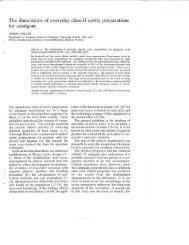

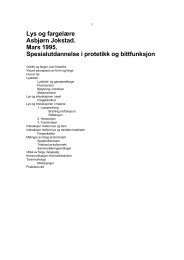

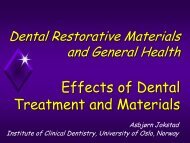
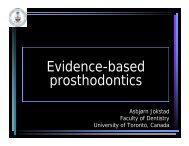

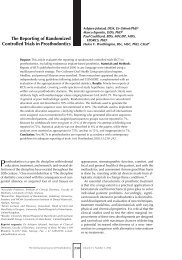
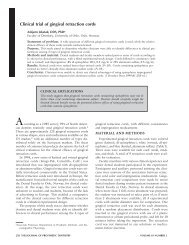

![[Sementer i fast protetikk] Scandinavian Society for Prosthetic](https://img.yumpu.com/18378889/1/190x245/sementer-i-fast-protetikk-scandinavian-society-for-prosthetic.jpg?quality=85)
